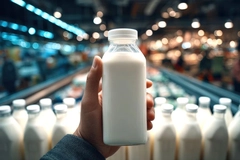Fraunhofer IVV develops peatland plant-based paper to reduce wood-sector dependence and chemicals

The German Fraunhofer Institute for Process Engineering and Packaging IVV (Fraunhofer IVV) has developed a paper packaging production process using plants that grow in peatland (a type of wetland environment), such as peat moss, reed and reed canary grass.
“It has been proven that packaging made from paludicultures [wet agriculture and forestry on peatlands] can have the same mechanical stability and processability as wood-based fiber material,” Mathias Kott, processes and machine integration expert at Fraunhofer IVV, tells Packaging Insights.
“Due to their advantages, such as lower lignin content, which allows less energy-intensive pulping processes, paludicultures could be an attractive alternative as a source of raw materials for paper packaging,” he continues.
Engineers at Fraunhofer IVV have now demonstrated the paper’s use in folding boxes, trays, paper jars and other similar items.
“This can also reduce the EU’s dependence on exports in the wood sector, as locally grown plants should preferably be processed.”
Wetlands offer opportunities
Kott argues that it is important to develop “value-creation opportunities” for the use of wetland areas, such as peat.
 Mathias Kott, processes and machine integration expert at Fraunhofer IVV.“The EU Restoration Act, for instance, which was passed by the EU Parliament in February 2024, requires forests, grasslands and wetlands, among other things, to be restored or at least 30% of the relevant area to be rewetted,” he says.
Mathias Kott, processes and machine integration expert at Fraunhofer IVV.“The EU Restoration Act, for instance, which was passed by the EU Parliament in February 2024, requires forests, grasslands and wetlands, among other things, to be restored or at least 30% of the relevant area to be rewetted,” he says.
“This will result in additional land for so-called paludicultures in the future. These are agricultural and forestry systems that are operated on rewetted organic soils with preservation of the peat body, such as peat moss, reeds, cattail and reed canary grass.”
While this may change in the near future, Kott points out that, as of present, “the cultivation and harvesting of paludicultures is considerably more expensive than the procurement of wood-based paper raw materials.”
“This will also be reflected in the price of packaging. The first packaging can be expected for high-quality products that are marketed for environmentally conscious consumers, for example, natural cosmetic products.”
Manufacturing and applications
Fraunhofer IVV’s peatland plant paper manufacturing process uses fiber-molding and deep-drawing processes.
The research team found that reeds and petland similar plants have a lower lignin content than wood. This allows the use of less chemicals during the pulping of plant fibers to reach the quality of fiber needed for packaging applications.
Additionally, the scientists say that lignin from such “non-woody” plants can be easily released or separated from the fibers, which makes the needed pulping methods less energy-intensive than those used in conventional paper manufacturing processes.
 Paper from peatland plants can be used for folding boxes, trays, paper jars and other similar items.Kott says that “due to the relatively simple processes, for example, for fiber molding, it is also conceivable to install corresponding processing plants directly in the agricultural companies.”
Paper from peatland plants can be used for folding boxes, trays, paper jars and other similar items.Kott says that “due to the relatively simple processes, for example, for fiber molding, it is also conceivable to install corresponding processing plants directly in the agricultural companies.”
“The harvested plants can, for example, be taken to local paper processors and packaging manufacturers for further processing. Such networks need to be established.”
However, he notes that “there may be limitations in terms of whiteness and color consistency. Other properties, such as coating options for durability and printability, still need to be investigated.”
“We are currently working intensively on finding industrial partners for such packaging applications and for the development of new applications.”











